| Description and behavior | Damage | Control | Repellents | Lethal controls | Shooting | Services and supplies | Other sparrow traps
The house sparrow, like many pest birds, was introduced to North America in the mid-1800s. Since then, the house or English sparrow (not a true sparrow but a European finch), has become one of the most widespread and adaptive birds found on this continent.
Description and Behavior
The house sparrow measures about 15 cm (5.75 in.) long and is only found in man-made habitats. The male has a distinctive black bib and white cheeks; the overall color of the smaller female is a plain dingy gray.
Sparrows primarily eat seeds, grains and garden plants. Insects make up two-thirds of the nestlings' diet, but are infrequently consumed by the adults. A study of sparrows' food habits showed that one half of their diet consisted of seeds, nuts and other human foods. Garbage, bread crumbs and fast food restaurant refuse can support sparrow populations in urban habitats.
Breeding can occur during any month, but is most common from March to August. Both parents feed and care for the young. Three to seven eggs hatch after 10 to 14 days of incubation. Young birds leave the nest at two and a half weeks of age.
The sparrow is a successful, hardy bird with no recognized migration pattern; adults remain within 2 to 6 km of where they were hatched. However, flocks of juveniles and non-breeding adults will move 6 to 8 km to new feeding areas. This is why removing sparrows from problem areas does not always succeed.
Damage
Sparrows damage crops and gardens by pecking seeds, seedlings, buds, flowers, vegetables and maturing fruits. They consume and spoil livestock food and water, and contaminate or deface buildings, facilities and livestock with their nests and droppings. They can also transmit many diseases and parasites of livestock, pets and humans.
Control
The best way to control sparrow problems is by exclusion. Replace or cover broken windows in upper stories with wire mesh, plastic, wood or sheet metal. Screen poultry houses and feeders to completely exclude sparrows. Seal all openings larger than 2 cm (0.75 in.). Warehouses, garages and farm buildings can effectively be blocked to sparrows by hanging plastic strips (10 - 15 cm wide) the full-length of open doorways. In livestock shelters, attach used net wraps with tacks or pieces of lath to the upper structures to prevent roosting.
Eliminate perch sites by fitting ledges and rafters with slanted boards at a 45 degree angle (see Figure 1).
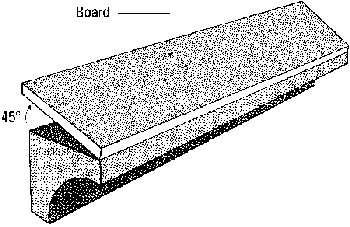
Figure 1. Ledge fitted with a slanted board
Keep sparrows away by stringing plastic bird netting (mist nets) over shrubs or vines. The mesh blends in with the plants and prevents birds from roosting and nesting.
Sparrows can be excluded from some areas by encouraging other birds to nest. Introduce sparrow-proof birdhouses with openings 2.8 cm (11/6 in.) or smaller. Many songbirds, such as wrens, can still use such a birdhouse.
Sparrows cannot tolerate being soaked with water, so to sparrow-proof a birdhouse (for example for blue birds), bore a 7 to 9 cm (3 - 3.5 in.) hole in the roof and cover it with 6 to 12 mm (0.25 - 0.5 in.) mesh. Remove or destroy old, abandoned farmyard buildings to discourage sparrows from nesting in the area. Sparrows prefer to travel short distances for food, and this measure forces them to build nests further from food sources.
Repellents
Repellents can be used to temporarily keep birds away from specified areas. One repellent is a tacky glue, which is applied to ledges and rafters and other areas where sparrows roost (Tacky Toes and Shoo). These messy compounds should be placed on tape or on clean surfaces. In time, these materials harden from weather and dust, but can remain effective for up to one year (see Figure 2).
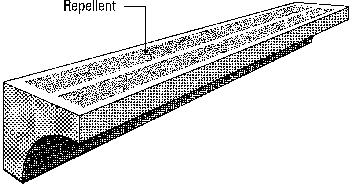
Figure 2. Window ledge covered with repellent
Porcupine quills, rows of metal spines attached to a base, make roosting impossible or uncomfortable. Quills can be useful, but remember that sparrows can roost on ledges only 12 mm (0.5 in.) wide.
Quills should be checked regularly and cleaned as sparrows may drop debris between the quills (see Figure 3).
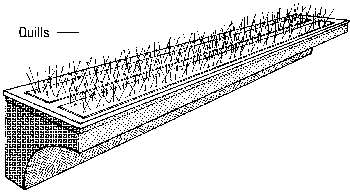
Figure 3. Window ledge covered with metal quills
Scarecrow-type devices, usually in the shape and size of birds of prey, can help drive sparrows away. Sparrows can also be frightened away by novelties such as shimmering silver and red aluminum foil strips. Using a selection of different techniques is the most effective approach to long term control.
Lethal Controls
Avitrol in ground cereal is a repellent bait. However, Avitrol can only be used under the supervision of government agencies or licensed pesticide applicators. Avitrol causes birds to behave abnormally and vocalize distress calls that scare the rest of the flock from the area.
Bait location and accessibility to birds is important for success with Avitrol. The bait platform should be elevated to 1.5 m or placed on roofs or high ledges, covered with 12 mm (0.5 inch) mesh 20 cm above the platform, and be large enough to accommodate several birds at once (60 cm x 60 cm).
Prebaiting (offering untreated food) for up to two weeks before using Avitrol will condition the birds to the bait area. After that time, place 250 to 500 g (0.5-1 lb) of treated bait on all bait platforms, or alternate platforms can be treated with prebait and Avitrol bait and then rotated every two weeks. Keep bait out until feeding stops or bird numbers have been reduced to an acceptable level.
To reduce accidental poisoning, bait platforms should be placed in areas inaccessible to wild and domestic birds and animals.
Post warning notices in treated areas until the completion of the treatment period.
Remove dead birds immediately after the bird problem is eliminated, and destroy them by burning.
Mist Nets of 12 mm (0.5 in.) mesh are helpful in removing sparrows from enclosed buildings. Allow the birds full access inside the building and then slowly close off all entrances, leaving a 2 m space at one door. Hang the mist net over the opening the entire length of the door. Chase the birds from the building by banging metal pots, sheet metal and so on. The frightened birds will fly into the net and harmlessly entrap themselves, making their removal easy and humane.
An alternative to the mist net is clear lightweight plastic sheeting. Use the same way as the mist net except midway down the plastic sheet, place an open plastic garbage bag supported by a metal or wooden frame. The birds should fly into the clear plastic and fall into the garbage bag. The top of the plastic sack should be covered quickly after birds fall into it.
Birds can be captured with various types of funnel traps, although birds can easily escape from some of them. Funnel traps must be baited to lure the birds inside. The trap should first be closed and bait should be scattered immediately outside the trap to condition the birds. After about a week, or when the birds seem to show no fear of the trap, place the bait inside the open trap (see Figure 4).
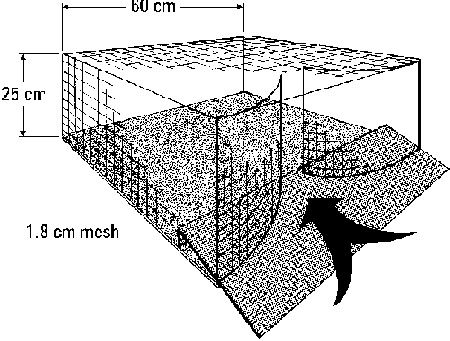
Figure 4. Walk-in trap.
Note: 10 to 15 cm incline deters birds from coming back out of the trap
Automatic traps such as the "Hava Hart" sparrow trap capture one bird at a time as it passes into the baited area. These traps work well, but are useful only where sparrow numbers are low.
Shooting
Where local bylaws permit, shooting with low-powered firearms (for example .177 or .22 calibre with birdshot only) can be successful. However, birds quickly become conditioned to humans holding anything resembling a firearm, so shooting from behind a blind and into an area baited with grain will give the best results.
Nest destruction by removal or wetting with oil after eggs are laid will discourage sparrows from staying in an area. Sparrows may lay more than one clutch per season, so repeat this operation at two to three-week intervals.
Services and Supplies
For further information on sparrow control, consult local bylaw officials or pest exterminators. Many of the devices, materials and registered pest control products are available in Alberta. Many suppliers handle a wide variety of pest bird control products.
Other Sparrow Traps
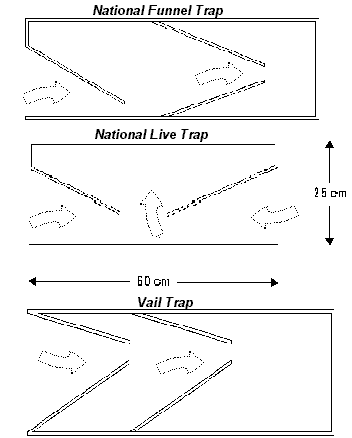 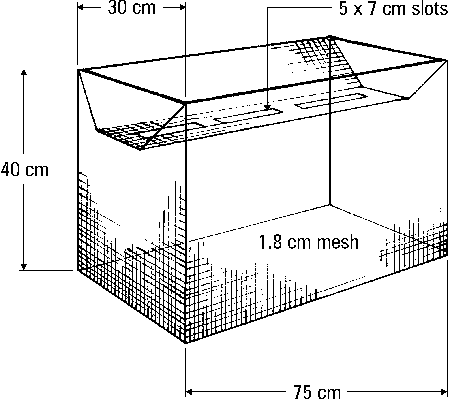
Prepared by:
Alberta Agriculture and Rural Development
More information, contact:
Alberta Ag-Info Centre
Call toll-free: 310-FARM (3276)
Source: Agdex 685-8. Revised January 2015.
|